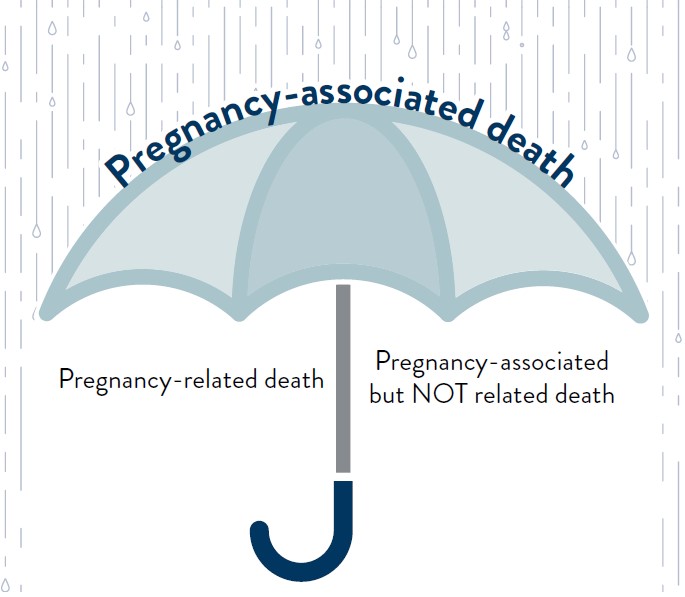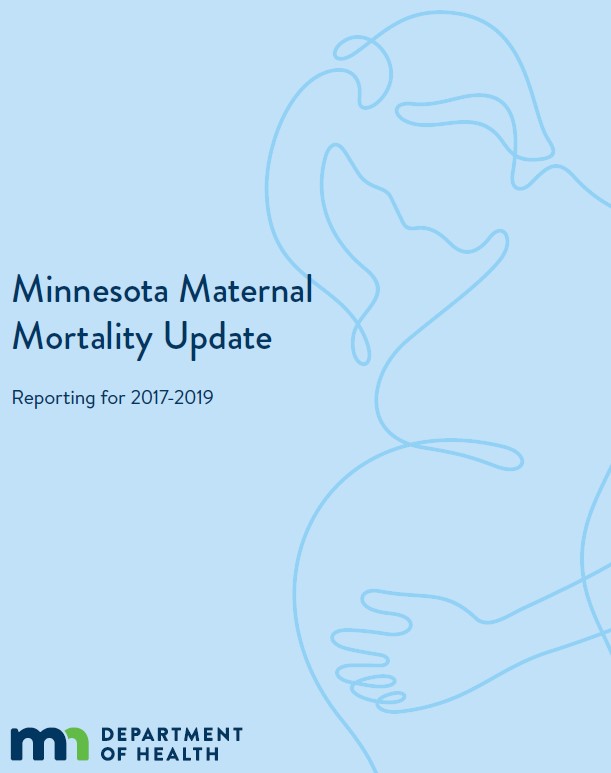Maternal Mortality
Maternal mortality definitions
In 1993, the Minnesota Department of Health (MDH) adopted the Center for Disease Control and Prevention (CDC) definition of maternal mortality:
- Pregnancy-associated death: A death during pregnancy or within one year of the end of pregnancy, irrespective of cause.
The following are subsets of pregnancy-associated maternal deaths:
- Pregnancy-related death: A death during pregnancy or within one year of the end of pregnancy from a pregnancy complication, a chain of events initiated by pregnancy, or the aggravation of an unrelated condition by the physiologic effects of pregnancy.
- Pregnancy-associated but NOT related death: A death during pregnancy or within one year of the end of pregnancy from a cause that is not related to pregnancy.

Maternal mortality in Minnesota
The Minnesota Department of Health’s maternal mortality review committee (MMRC) reviewed 48 pregnancy-associated deaths in Minnesota that occurred during 2017-2018. Pregnancy-associated death is a death that occurs during pregnancy or within one year of termination of pregnancy irrespective of cause. The findings of the review committee and recommendations can be found in Minnesota’s first maternal mortality report. This report also includes demographic information and characteristics of pregnancy- associated deaths of Minnesotans, summarizes the causes of deaths, and factors contributing to these deaths.
Recommendations from review of pregnancy-associated deaths
The MMRC’s goal is to identify contributing factors and recommendations to prevent future deaths for the identified pregnancy-associated deaths. Key recommendations from reviewed deaths from 2017-2019 are:
- Expand Medicaid coverage to include benefits immediately beginning during the prenatal period and at one year postpartum. As of July 1,2022, Medical Assistance will now extend one year postpartum.
- Support statewide improvements for birthing people who have substance use disorders (SUD) or mental health conditions, including adequate identification of substance use and mental health conditions in the birthing population, referral to behavioral health services and support groups, and increased funding to expand treatment and access to treatment throughout the state.
- Develop standardization of referral network within systems and regions to refer birthing people to locations for appropriate level of care, and to decrease delay in needed diagnostics, interventions, or elevation of care.
- Improve the postpartum period by assuring that birthing people have access to care team no later than three weeks postpartum.
- Address bias in systems perpetuating disparities in the birthing population. Acknowledge historical trauma and racism and the impacts on birthing people.
- Fund community lead networks and support systems to provide culturally informed care to fit birthing person’s needs.
- Listen and support birthing people. Listen to concerns, provide a network of support during and after the postpartum period.
To learn more, review recommendations found in the Minnesota Maternal Mortality Report: Reporting for 2017-19 (PDF). Updated maternal mortality data from the Minnesota maternal mortality review is now available on pregnancy-associated deaths occurring from 2017-2019. This updated data builds upon the Minnesota maternal mortality report 2017-18, with the aim of further developing recommendations for action in the realm of maternal health. Use the original report’s data as a guide to better understand these findings. The recommendations from the previous report are still applicable. The release of the new update, adds more actionable recommendations for the state to address pregnancy-associated deaths.
- Minnesota Maternal Mortality Report: Reporting for 2017-2019 (PDF)
- Minnesota Maternal Mortality Report 2017-2018 (PDF)
- Recommendations from Review of 2017 Cases (PDF)
- Recommendations from Review of 2016 Cases (PDF)
Maternal mortality nationally
The Centers for Disease Control and Prevention (CDC) has many tools and resources regarding maternal mortality. CDC is committed to preventing pregnancy-related deaths and ensuring the best possible birth outcomes. Learn more by visiting Preventing Pregnancy-Related Deaths.
The following reports from the CDC provide an overview of national maternal mortality data.
- CDC: Pregnancy-related deaths: Saving women's lives before, during and after delivery (PDF)
- Maternal Mortality Rates in the United States, 2021
This report is a focused evaluation of 36 states’ pregnancy mortality surveillance systems from 2017-2019, analyzing preventability and factors contributing to pregnancy-related deaths.
This report uses data on pregnancy-related deaths among residents of 36 states from 2017 to 2019 shared with CDC through the Maternal mortality review information application (MMRIA). This report describes pregnancy-related deaths among all American Indian or Alaska Native persons (AIAN), which includes non-Hispanic single-race AIAN, and AIAN in combination with any other race or ethnicity.
Minnesota maternal mortality review project
Per Minnesota Statute 145.901, “the commissioner of health may conduct maternal death studies to assist the planning, implementation, and evaluation of medical, health, and welfare service systems and to reduce the numbers of preventable maternal deaths in Minnesota.” To that end, a Minnesota maternal mortality review project was reinstituted in 2012 to review maternal deaths and examine the circumstances surrounding maternal deaths, identify risk factors for maternal mortality and make recommendations and interventions for reducing or eliminating future deaths in women of reproductive age.
The Minnesota maternal mortality review process
Step 1: Case findings
The Minnesota Department of Health (MDH) conducts surveillance of maternal deaths through standard and enhanced surveillance methods.
- Physician and hospital reporting
- Pregnancy status check box on death certificate
- ICD-10 codes
- Matching death certificates from any female death between the ages of 5-70 with birth certificates and/or fetal death certificates.
For more information on reporting deaths, see the Maternal Death Reporting Form (PDF).
Step 2: Assemble available medical records and information
Minnesota Statute 145.901 allows for the collection maternal medical records in accordance with the statute purpose. Decedent information is requested from multiple sources. Death certificates, birth certificates, medical records, autopsy reports, police reports and obituaries are some sources of information that are requested and collected. All available relevant medical records from a woman’s pregnancy, labor, birth, postpartum and other medical care are gathered to review the circumstances leading up to her death. The investigation of the maternal case aims to gain insight into the various factors (health, social, geographic, cultural, spiritual, psychological, environmental, economic, or other) that lead to the maternal death and to identify factors that may be preventable. This information is abstracted and developed into a case narrative, which is then reviewed by the Minnesota Maternal Mortality Review committee.
Step 3: Minnesota maternal mortality review committee
The Minnesota Maternal Mortality Review Committee (MMRC) reviews all pregnancy-associated deaths occurring in Minnesota residents and is authorized in Minnesota Statutes 145.901. More information on the MMRC can be found on the MMRC webpage.
Step 4: Analysis
Maternal information is abstracted and analyzed in the maternal mortality review information application (MMRIA). This application developed by the CDC, provides for a standardization of surveillance, information collection, and monitoring of maternal mortality rates, allowing states to detect similar trends.
Step 5: Use of recommendations
The recommendations from the Minnesota maternal mortality review project can be used to:
- Identify themes or trends in maternal mortality in Minnesota over time.
- Inform maternity care providers and clinical practice and community stakeholders.
- Offer relevant public health interventions for women of reproductive age.
- Provide opportunities for quality improvement.
- Determine where resources should be allocated in the State.
- Influence policy at the state and local level.
Helpful resources
The following are national resources focused on maternal mortality:
- World Health Organization - Maternal Mortality
- Centers for Disease Control and Prevention - Maternal Mortality
- Building U.S. Capacity to Review and Prevent Maternal Deaths
- National Network of Perinatal Quality Collaborative
- Association of Maternal & Child Health Programs - Maternal Health
- March of Dimes - Maternal Death and Pregnancy - Related Death
- Alliance for Innovation on Maternal Health Program
- Maternal Health Learning Center
